Contents
- 1 WHERE IS HOI AN?
- 2 WHEN IS HOI AN RECOGNIZED AS WORLD HERITAGE SITE?
- 3 WHY IS HOI AN SO FAMOUS?
- 4 HOI AN VIETNAM TRAVEL BLOG: WHEN IS THE BEST TIME TO VISIT HOI AN?
- 5 WHAT TO DO IN HOI AN?
- 6 WHAT ARE THE ACTIVITIES/EVENTS IN HOI AN YEARLY?
- 6.1 1. Hoi An Lantern Festival (Monthly):
- 6.2 2. Mid-Autumn Festival (September/October):
- 6.3 3. Hoi An Full Moon Festival (Monthly):
- 6.4 4. Hoi An International Food Festival (April/May):
- 6.5 5. Hoi An New Year’s Eve Countdown (December 31):
- 6.6 6. Quang Nam Heritage Festival (Every few years):
- 6.7 7. Hoi An Eco-Tourism Festival (Annually):
- 6.8 8. Hoi An International Marathon (March/April):
- 7 WHAT ARE THE POPULAR FOOD TO ENJOY IN HOI AN?
- 8 WHAT ARE THE BEST RESTAURANTS IN HOI AN?
- 9 WHAT ARE THE BEST HOTELS TO STAY IN HOI AN?
- 10 WHAT ARE THE BEST HOME STAYS TO STAY IN HOI AN?
- 11 WHAT ARE BEST CAFES IN HOI AN?
- 12 WHAT ARE BEST TAILORS IN HOI AN?
- 13 WHICH ARE THE BEST PLACES FOR MONEY EXCHANGE IN HOI AN?
- 14 WHAT ARE ESSENTIAL TIPS IN HOI AN FOR CONSIDERATION?
- 15 WHAT IS THE BEST HOI AN TRAVEL AGENCY TO BOOK PRIVATE TOURS?
WHERE IS HOI AN?
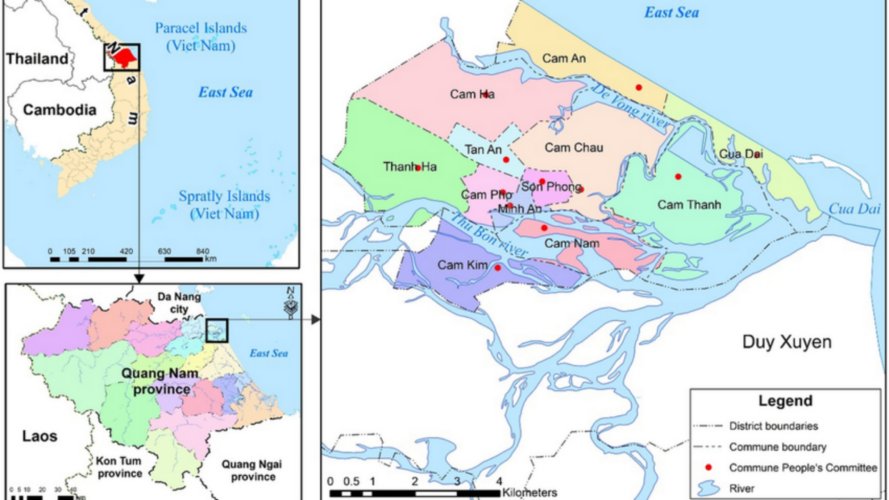
The lovely town of Hoi An is situated in the center of Vietnam. It is located in Quang Nam Province, which is along the South East Sea coast of the nation. Hoi An is renowned for its picturesque old town center, well-preserved historical architecture, and designation as a UNESCO World Heritage Site. Due to its rich cultural legacy, lantern-lit alleys, and lively atmosphere, the town is a well-liked tourist attraction in Vietnam.
WHEN IS HOI AN RECOGNIZED AS WORLD HERITAGE SITE?
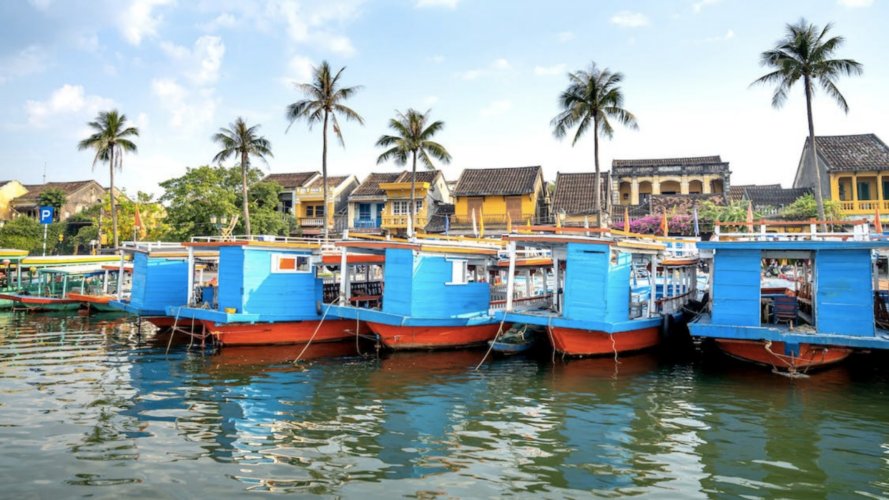
On Dec 4th, 1999, UNESCO designated Hoi An as a World Heritage Site. A combination of native and foreign influences may be seen in the extraordinarily well-preserved and historically significant building that led to its classification as a World Heritage Site. This acknowledgment has aided in the protection and preservation of the town’s distinctive cultural legacy, making it a well-liked destination for tourists interested in learning more about Vietnam’s extensive history and impressive architecture.
WHY IS HOI AN SO FAMOUS?
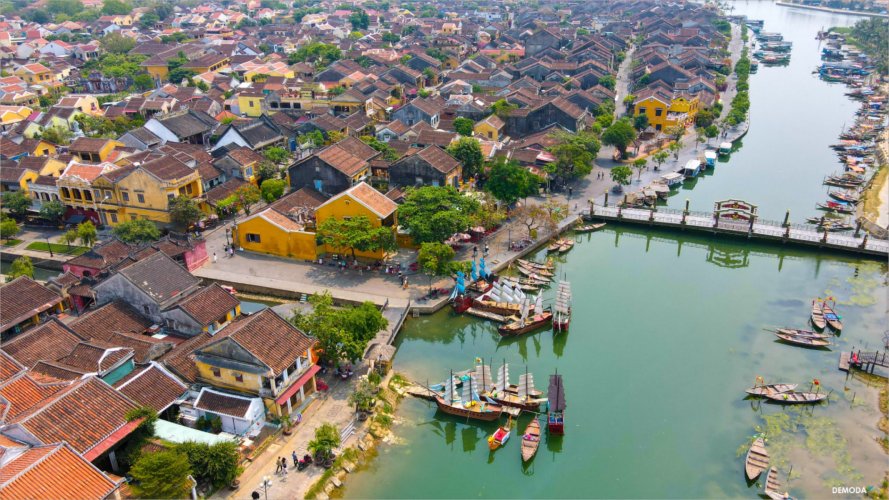
The fame of Hoi An is due to its alluring fusion of history, culture, and beauty. The well-preserved architecture in this historic town, a UNESCO World Heritage Site, displays influences from the Vietnamese, Chinese, Japanese, and European cultures. Its quaint alleyways lighted by lanterns, lovely waterways, and bustling markets provide a window into Vietnam’s colorful history. Custom clothing is made by trained artisans in Hoi An, which is renowned for its traditional tailoring. Unique meals like Cao Lau and White Rose Dumplings are among the exquisite cuisine’s offerings. The village attracts tourists looking for an authentic and culturally immersed experience in Southeast Asia because of its warm welcome and peaceful atmosphere.
HOI AN VIETNAM TRAVEL BLOG: WHEN IS THE BEST TIME TO VISIT HOI AN?
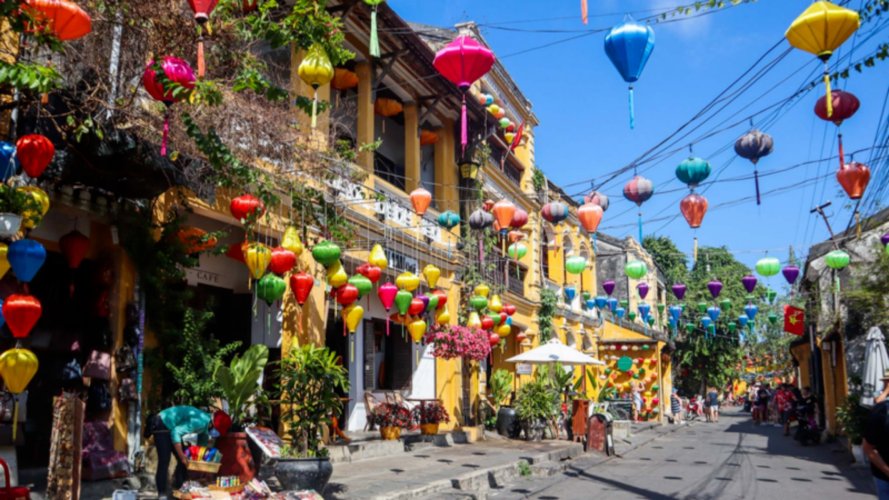
The dry season, which runs from February to August, is considered the ideal time to visit Hoi An, Vietnam. The seasons are broken out as follows:
The spring season, from February through April, is the best time to go because of the pleasant and dry weather. The weather is pleasant, and you may take in the stunning views of flower-filled landscapes.
Early Summer (May to June): The weather is still warm and there is still little rain at this time. It’s a beautiful season for outdoor activities because the countryside is lush and green.
Late Summer (July to August): If you can stand the heat, you’ll still only see a little bit of rain throughout these months. This is a popular time to visit the beaches.
Hoi An Vietnam Travel Blog concern if coming to Hoi An from September to January, when there is a larger chance of flooding and heavy rainfall in Hoi An. Travel arrangements and some activities may be restricted by flooding. While each season has its charms, you should think about scheduling your trip for the dry months, particularly from February to April, for the most pleasant and enjoyable experience.
WHAT TO DO IN HOI AN?
1. Visit Traditional villages:
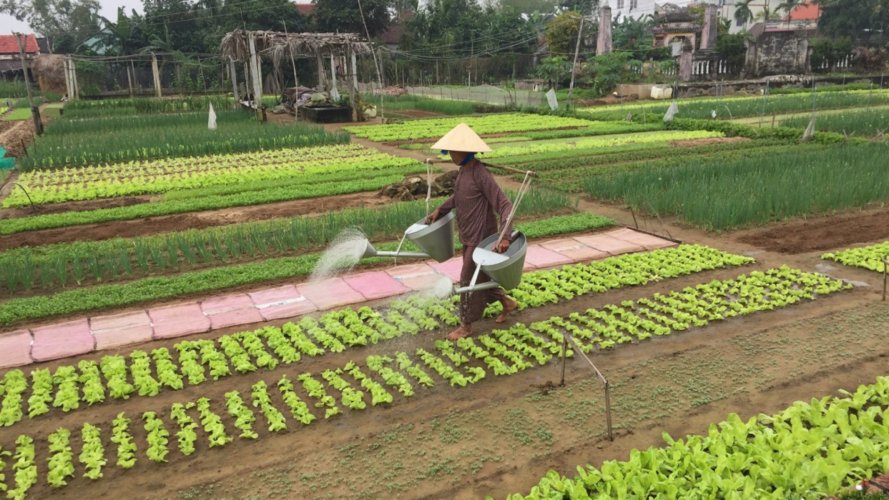
Hoi An is known for its rich cultural heritage and traditional villages that offer visitors a glimpse into the region’s history and craftsmanship. Here are three traditional villages in Hoi An:
A. Kim Bong Carpentry Village:
Located on Cam Kim Island, just across the Thu Bon River from Hoi An’s Old Town, Kim Bong Carpentry Village has a long-standing reputation for skilled woodworking. Artisans in this village have been crafting wooden furniture, boats, and other products for generations. Visitors can witness the intricate woodcarving techniques and see how traditional Vietnamese wooden fishing boats are constructed. Kim Bong Village provides a unique opportunity to explore the artistry of Vietnamese carpentry.
B. Tra Que Vegetable Village:
Situated a short bicycle ride from Hoi An’s center, Tra Que is a charming village famous for its organic vegetable farming. The nutrient-rich soil here produces a wide variety of herbs and vegetables used in traditional Vietnamese cuisine. Visitors can participate in hands-on activities like planting, watering, and harvesting vegetables. Tra Que Village offers cooking classes where you can learn to prepare authentic dishes using the freshly harvested produce.
C. Thanh Ha Pottery Village:
Thanh Ha is a historic pottery village located just a few kilometers west of Hoi An’s Old Town. It has a heritage dating back several centuries, with artisans creating pottery using traditional techniques. You can observe the pottery-making process, from shaping and decorating clay to firing the finished products in kilns. Thanh Ha pottery is renowned for its quality and distinctive designs. Visitors can even try their hand at pottery-making under the guidance of skilled craftsmen.
These traditional villages not only offer a chance to learn about Vietnamese craftsmanship but also provide immersive cultural experiences that showcase the enduring traditions of the region.
2. Do Some Hoi An Eco Tours
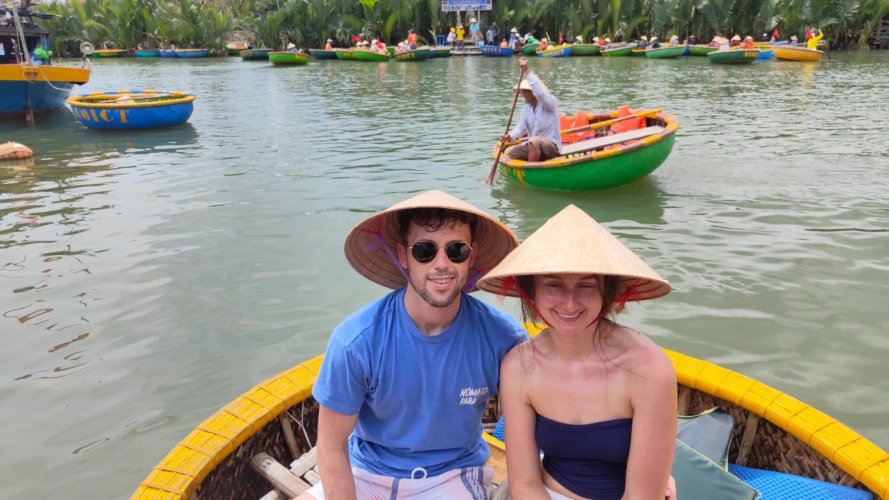
A. Hoi An Bicycle Tour
Doing Hoi An Bicycle Tour, it is an enjoyable way to explore the picturesque town and its surroundings. Typically, such a tour give you Scenic Ride through the charming streets of Hoi An’s Old Town, which is a UNESCO World Heritage Site. You’ll pedal along narrow alleys, past historic buildings, and under colorful lanterns, immersing yourself in the town’s unique atmosphere. In addition, you can explore Hoi An Countryside. You’ll cycle through lush rice paddies, picturesque villages, and alongside tranquil canals. Along the way, you may stop at traditional villages, such as Thanh Ha Pottery Village or Tra Que Vegetable Village, where you can interact with locals and learn about their traditional crafts or farming practices. Some tours include visits to local markets or food stalls, allowing you to savor delicious Vietnamese cuisine and street food. This is an excellent opportunity to taste regional specialties.
Overall, a Hoi An bicycle tour offers a unique and immersive way to experience the town and its surroundings, combining cultural exploration, scenic beauty, and a touch of adventure as you pedal through this enchanting part of Vietnam.
B. Hoi An Farming and Fishing Tour
Hoi An Farming and Fishing Tour provides an immersive experience that connects you with the traditional livelihoods of the local community. During this tour, you’ll have the opportunity to engage in hands-on activities and gain insights into the region’s agrarian and aquatic practices. Starting with a visit to a nearby farming village, you’ll work alongside farmers, tending to rice paddies or vegetable gardens, and learn about the sustainable farming techniques that sustain the local agriculture. Afterward, you’ll embark on a fishing adventure, either on a traditional basket boat or with local fishermen. This hands-on fishing experience involves casting nets, catching fish, and even trying your hand at paddling the unique round boats. These tours often culminate in a cooking class, where you can prepare and enjoy a meal using the fresh ingredients you harvested or caught, providing a comprehensive and memorable cultural experience in Hoi An.
C. Hoi An Basket Boat Tour
Hoi An round boat tour offers a unique and iconic experience in this charming Vietnamese town. These round boats, often called “basket boats” due to their shape, are traditionally crafted from bamboo and are a distinctive part of the local culture. During the tour, you’ll board one of these small, circular boats and venture out onto the tranquil waterways that crisscross the Hoi An countryside. As you paddle along, you’ll be surrounded by lush greenery, rice paddies, and serene canals, immersing yourself in the peaceful rural scenery. Many tours include a visit to traditional fishing villages, where you can observe local fishermen at work and even try your hand at casting nets or paddling the round boat yourself. The experience provides a close connection to the traditional way of life in Hoi An and offers an opportunity to appreciate the natural beauty of the region.
3. Visit Tourist Attractions in the Old Town
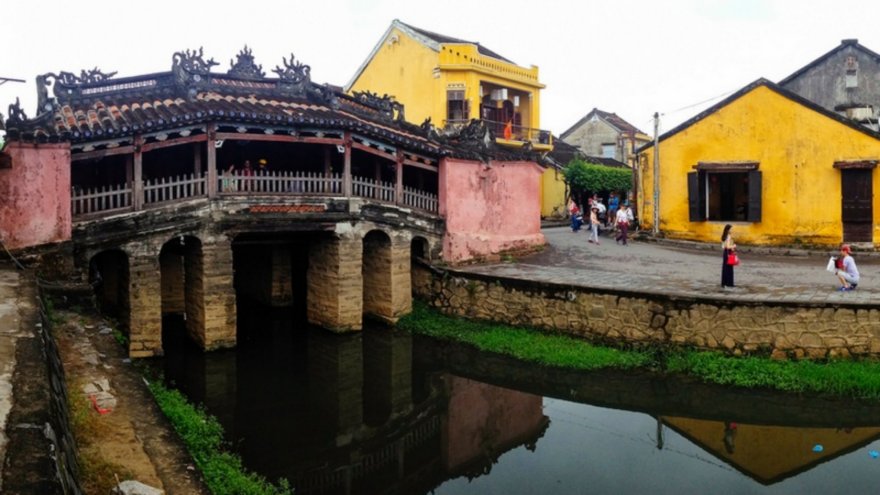
A. Japanese Bridge
The Japanese Covered Bridge in Hoi An, Vietnam, is a symbol of the town’s rich history and cultural diversity. Dating back to the 18th century, this iconic bridge features a unique combination of Japanese, Chinese, and Vietnamese architectural elements. It spans a small canal and connects the Japanese and Chinese quarters of the town. The bridge is renowned for its graceful curve and its ornate decorations, including intricate carvings and a small temple inside. Visitors can explore this well-preserved piece of history, which stands as a testament to Hoi An’s role as a vital trading port and a place where different cultures converged and thrived.
B. Tan Ky Old House
Tan Ky Old House, located in Hoi An, Vietnam, is a remarkable testament to the town’s architectural and cultural heritage. This 200-year-old merchant house beautifully exemplifies a blend of architectural styles, including Japanese, Chinese, and Vietnamese influences. The house’s name, “Tan Ky,” means “Progress Shop,” reflecting its history as a thriving business. Inside, intricately carved wooden beams, antique furniture, and precious artifacts showcase the wealth and taste of generations past. Visitors can explore the house, marveling at its exquisite craftsmanship and learning about its storied past, which offers a window into Hoi An’s role as a bustling trading hub along the Thu Bon River.
C. Fujian Chinese Assembly Hall
The Fujian Chinese Assembly Hall, situated in Hoi An, Vietnam, is a cultural and architectural gem. Built in the late 17th century, this historic hall served as a meeting place and a spiritual center for Fujianese immigrants who settled in the area. The hall is renowned for its intricate woodwork, ornate sculptures, and vibrant mosaic tiles. The central courtyard features a picturesque garden with a pond filled with carp, offering a tranquil escape from the bustling streets of Hoi An. Visitors can admire the exquisite craftsmanship and learn about the cultural significance of this well-preserved structure, which stands as a testament to the Chinese community’s enduring legacy in Hoi An.
D. Cantonese Chinese Assembly Hall
The Cantonese Chinese Assembly Hall, located in Hoi An, Vietnam, is a historical and cultural treasure. Constructed in the 19th century by the local Cantonese community, this ornate hall served as a communal gathering place and a place of worship. Its architecture is a testament to the Cantonese style, featuring intricate woodwork, decorative carvings, and stunning porcelain figurines. The main altar is dedicated to Thien Hau, the Goddess of the Sea, revered by seafarers for protection. Visitors can explore the hall’s intricate details, colorful motifs, and serene courtyards, gaining insights into the rich heritage of the Cantonese community and their contributions to Hoi An’s cultural tapestry.
E. Museum of Folklore in Hoi An
The Museum of Folklore in Hoi An, Vietnam, is a captivating institution dedicated to preserving and showcasing the region’s rich cultural heritage. Housed in a beautifully preserved historic building, the museum offers a comprehensive collection of artifacts, exhibits, and displays that highlight the traditions, rituals, and daily life of the local people. Visitors can explore traditional costumes, religious artifacts, musical instruments, and other cultural relics that provide insights into the customs and beliefs of the Hoi An community. This museum offers an educational and immersive experience, making it a must-visit for those seeking a deeper understanding of the cultural tapestry of Hoi An and its surrounding regions.
F. Traditional performance house in Hoi An
This performance gives you traditional Vietnamese performances, such as folk music, dance, and theater, which are often an integral part of the cultural experience in Hoi An. These performances typically showcase traditional stories, legends, and local customs that you will find it very interesting.
G. Hoi An Market
Hoi An Market, located in the heart of Hoi An’s Old Town, is a bustling and vibrant hub of commerce and culture. This traditional market is a sensory delight, offering a wide array of fresh produce, spices, seafood, clothing, handicrafts, and souvenirs. The market comes alive with colorful stalls and the energetic chatter of vendors and shoppers. It’s a fantastic place to immerse yourself in the local lifestyle, sample Vietnamese street food, and shop for unique items like tailored clothing and handmade crafts. Hoi An Market is not just a shopping destination but also a cultural experience that captures the essence of this historic town.
4. Join a Cooking Class in Hoi An
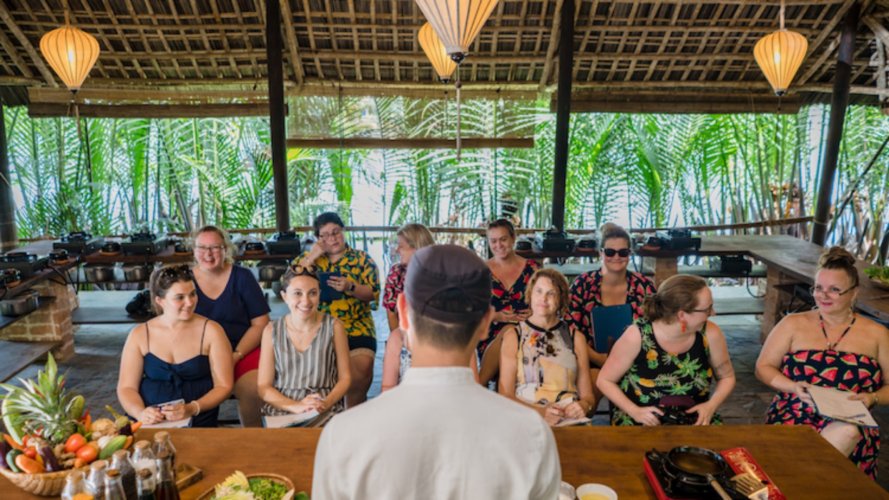
Hoi An cooking classes are a popular and enriching experience for visitors to this historic town in Vietnam. Led by skilled local chefs, these classes offer hands-on opportunities to learn the art of Vietnamese cuisine. Participants typically begin by visiting local markets to select fresh ingredients, gaining insights into the vibrant world of Vietnamese food culture. Back in the kitchen, they are guided in preparing traditional dishes like pho, spring rolls, and banh mi, while discovering the intricacies of flavors and techniques. These classes provide a deeper appreciation for Vietnamese cuisine and allow participants to savor the fruits of their labor, making them a memorable part of the Hoi An experience.
5. Visit Popular Places around Hoi An
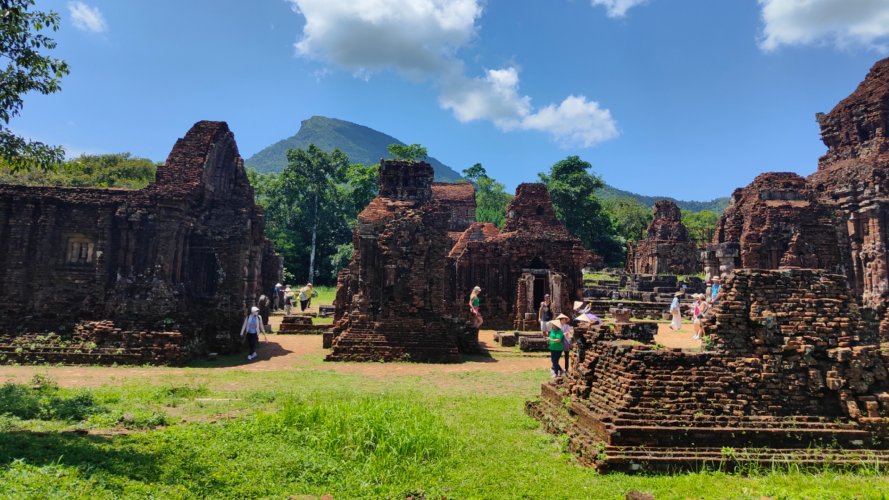
A. My Son Sanctuary
Vietnam’s Quang Nam Province is home to the UNESCO World Heritage Site known as My Son Sanctuary. It is a fascinating archaeological site that, between the fourth and the thirteenth centuries, served as the political and spiritual hub of the ancient Champa Kingdom. My Son is well known for its magnificent Hindu temple ruins, which are hidden among lush jungles and distinguished by their elaborate carvings and red-brick construction. These temples, which were built to honor gods like Shiva, are examples of the Cham people’s highly developed architectural and cultural achievements. My Son continues to be a fascinating tribute to Vietnam’s old history and cultural heritage despite the effects of time and war.
B. Marble Mountains
Five limestone and marble hills together referred to as the Marble Mountains are situated south of Da Nang, Vietnam. These natural wonders have enormous cultural and spiritual importance in addition to being a remarkable geological structure. Thuy Son (Water), Moc Son (Wood), Hoa Son (Fire), Kim Son (Metal), and Tho Son (Earth) are the names of the five elements that each mountain is named after. From their summits, visitors can take in expansive views of Da Nang and the nearby coastline as well as explore caves, pagodas, and grottoes studded with Buddhist and Hindu temples. The Marble Mountains provide a seamless fusion of historical significance, spirituality, and natural beauty.
C. Cham Island
Eight little islands collectively referred to as “Cu Lao Cham” in Vietnamese as “Cham Island” are situated off the coast of Hoi An. These islands are renowned for their immaculate beaches, clear waters, and abundant marine life, which makes them a well-liked vacation spot for those who enjoy snorkeling, diving, and other water activities. As a result of its diverse biodiversity and distinctive ecosystems, Cham Island is also designated as a UNESCO Biosphere Reserve. Visitors can discover fishing communities, hike through lush forests, and eat fresh seafood on the largest island, Hon Lao, which is inhabited. With its secluded beaches and scenic surroundings, it provides a peaceful respite from mainland Hoi An’s bustling.
D. Son Tra Peninsula Da Nang
The Son Tra Peninsula, a breathtaking coastal region known for its rich natural beauty and ecological significance, is situated in Da Nang, Vietnam. It is often referred to as Monkey Mountain and is the habitat of a wide variety of plants and animals, including endangered species like the red-shanked douc langur. From the crest of the peninsula, visitors may take in stunning panoramic views of Da Nang city, the East Sea, and the surrounding landscapes while exploring pristine beaches, hiking routes, and deep forests. Another notable sight on Son Tra is the Linh Ung Pagoda, which is home to a sizable figure of the Lady Buddha and gives this gorgeous coastal community additional cultural and spiritual value.
E. Cham Sculpture Museum Da Nang
A fascinating organization devoted to conserving and promoting the artwork and culture of the ancient Cham civilization is the Cham Sculpture Museum in Da Nang, Vietnam. The museum, which was founded in 1919, is home to a sizable collection of Cham sculptures, artifacts, and artifact fragments that date from the 7th to the 15th century. These elaborately carved stone objects, which include statues, reliefs, and portions of buildings, provide important insights into the Champa Kingdom’s artistic and religious practices. The sculptures are set against the tranquil backdrop of the museum’s lush gardens, which also serve as an educational and culturally enlightening experience that sheds light on Vietnam’s extensive historical past.
F. Ba Na Hills Golden Bridge

The Golden Bridge in Ba Na Hills, Vietnam, is a magnificent and enduring architectural wonder that has drawn admiration from all over the world. The Ba Na Hills resort complex near Da Nang is home to this magnificent pedestrian bridge, which is around 1,400 meters above sea level and known for its unique architecture. It has two giant stone hands holding up a shining golden pedestrian walkway that protrudes from the green hills. The 150-meter-long bridge offers sweeping views of the surrounding countryside.
The Golden Bridge, which was inaugurated in 2018, has rapidly grown to become a must-visit location and a representation of Vietnam’s tourism economy. The bridge is a favorite location for tourists and photographers due to its distinctive and artistic design and the stunning mountain scenery. It has established itself as one of Vietnam’s most recognizable attractions by providing a weird and otherworldly experience that combines the beauty of nature with human inventiveness.
G. Hai Van Pass and Lang Co town
The magnificent Hai Van Pass is a mountain pass in central Vietnam that is well-known for both its natural beauty and historical significance. It crosses the Annamite Range between Thua Thien-Hue Province and Da Nang City, providing panoramic views of the South China Sea, verdant hills, and scenic scenery. The pass, which served as a natural barrier and a vital military route, was crucial to the development of Vietnam.
A lovely seaside community called Lang Co may be found at the base of the Hai Van Pass. Lang Co is a sanctuary for beach lovers and fans of water sports because of its immaculate beaches and peaceful atmosphere. It is a well-liked location for leisure and water sports like swimming and fishing because of its azure waters, white sand beaches, and lush hills. The stunning coastline scenery of Lang Co and the dramatic landscape of the Hai Van Pass make this area a must-see for tourists traveling central Vietnam.
H. Hue Ancient capital
From 1802 to 1945, Hue, a city in central Vietnam on the banks of the Perfume River, served as the Nguyen Dynasty’s imperial capital, making it a significant historical and cultural hub. The Imperial City (also known as the Citadel), a huge complex of palaces, temples, walls, and gates that functioned as the political and administrative center of the dynasty, is one example of the city’s well-preserved historic architecture.
The Forbidden Purple City, where the emperor and his immediate family lived, is part of the Imperial City, a UNESCO World Heritage Site. The complex features conventional Vietnamese architecture and design, influenced by French and Chinese aesthetics.
Hue is renowned for its beautiful Perfume River, which is lined with pagodas and royal tombs. These historical landmarks, which offer insights into Vietnamese history and culture, are dispersed throughout the riverbanks and include the Thien Mu Pagoda and the Tomb of Emperor Minh Mang.
Hue is now a fascinating location for tourists interested in learning about Vietnam’s imperial past and architectural magnificence because of its rich legacy and historical significance.
WHAT ARE THE ACTIVITIES/EVENTS IN HOI AN YEARLY?
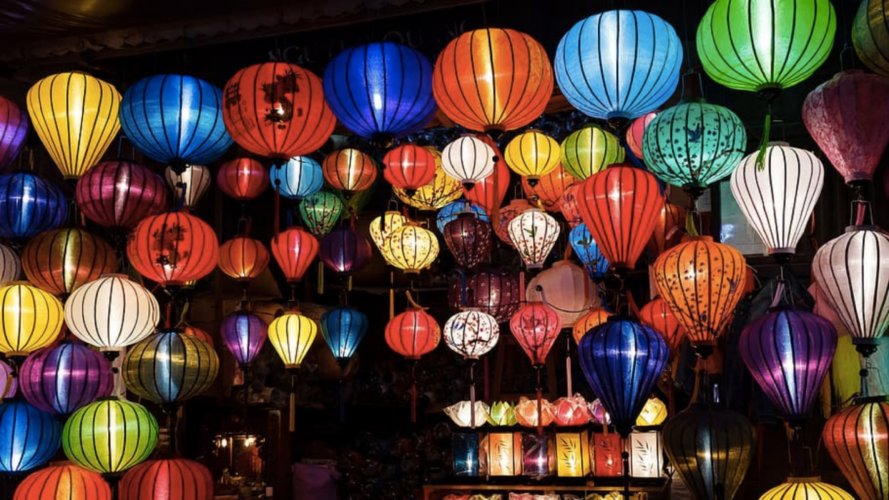
Hoi An hosts several annual activities and events that are worth a visit for tourists and travelers looking to immerse themselves in the local culture and festivities. Some of the notable ones include:
1. Hoi An Lantern Festival (Monthly):
This event takes place on the 14th day of each lunar month, transforming Hoi An’s Old Town into a magical wonderland with thousands of colorful lanterns, traditional performances, and cultural activities.
2. Mid-Autumn Festival (September/October):
Celebrated by the local community and visitors, this festival features vibrant lantern parades, traditional games, and mooncakes.
3. Hoi An Full Moon Festival (Monthly):
Coinciding with the Lantern Festival, this event offers a special atmosphere with streets closed to traffic, cultural performances, and a chance to explore the Old Town by lantern light.
4. Hoi An International Food Festival (April/May):
A culinary celebration featuring international and local chefs, offering a diverse range of cuisines and culinary demonstrations.
5. Hoi An New Year’s Eve Countdown (December 31):
The town comes alive with fireworks, music, and festivities as locals and tourists welcome the New Year.
6. Quang Nam Heritage Festival (Every few years):
A regional event showcasing the heritage and culture of Quang Nam Province, which includes Hoi An. It features traditional music, dance, and art performances.
7. Hoi An Eco-Tourism Festival (Annually):
Promotes sustainable tourism practices with eco-friendly activities, showcasing the region’s natural beauty.
8. Hoi An International Marathon (March/April):
An annual sporting event attracting runners from around the world, offering scenic routes through Hoi An and its surroundings.
These events and activities provide opportunities to engage with Hoi An’s rich cultural heritage, savor its culinary delights, and enjoy the lively atmosphere of this historic town throughout the year. It’s advisable to check the exact dates and schedules in advance when planning your visit.
WHAT ARE THE POPULAR FOOD TO ENJOY IN HOI AN?
1. Cao Lau
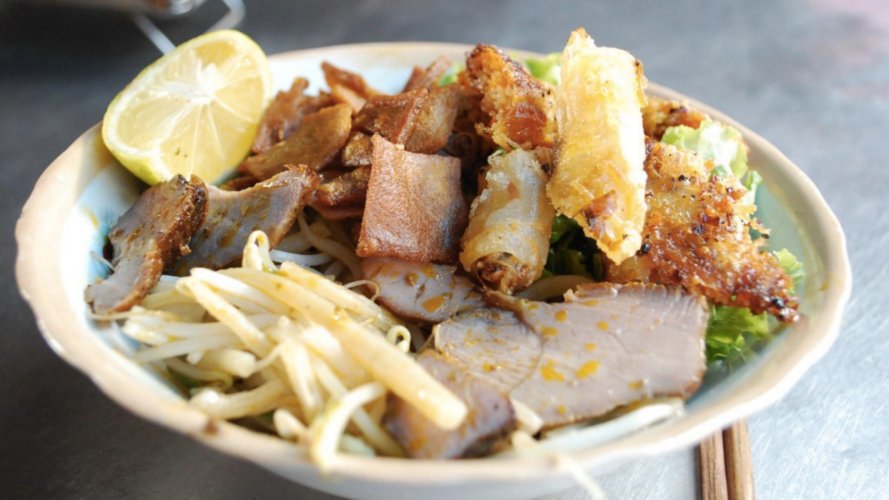
Vietnam’s national meal, cao lau, is renowned for its distinctive fusion of tastes and textures. This well-known meal is made with water from a particular well in the town and boasts thick, flat noodles that are unique to Hoi An. Slices of tender, fragrant pork that have been marinated and slowly cooked go well with these noodles. The dish is given a refreshing contrast by the use of fresh herbs and vegetables including mint, basil, and bean sprouts. A delicious crunch is also added by the thin squares of crispy rice paper that are frequently added to Cao Lau. A flavorful sauce or broth, the recipe for which is tightly guarded by local cooks, is poured over the components to finish the dish. Cao Lau provides a great dining experience that embodies food and culture of Hoi An town.
2. Quang Noodle
Cao lu Quang, also known as Quang noodle, is a well-known Vietnamese noodle dish that originated in the Quang Nam Province and is frequently linked with Hoi An and Da Nang. Wide, flat rice noodles are utilized in this regional specialty, and they have a characteristic yellow color because they were soaked in water that had been infused with ash from particular nearby trees. Crushed peanuts, fresh herbs, and fried shallots are frequently used as garnishes to quang noodles, which are frequently served with a range of proteins like shrimp, pork, or chicken. The meal is renowned for its flavorful broth or sauce, which is often served separately so that guests can adjust the flavor to their preference. Quang noodles are a must-try Vietnamese culinary experience because they provide a delicious combination of textures and flavors.
3. Wonton
In the historic town of Hoi An, a delicious Vietnamese cuisine with Chinese characteristics known as “Hoành Thánh Hi An” is a local favorite. These tiny, thin-wrapped wontons are filled with a flavorful filling that is often made of ground pork, shrimp, herbs, and spices. They are sometimes folded into deft designs that resemble dumplings or blooms. Hoi An wontons are a well-liked option for a hearty and satisfying lunch because they are typically served in a clear and tasty soup. Fresh herbs, crispy shallots, and perhaps a dash of freshly ground black pepper are used to garnish the dish. For food lovers discovering the varied flavors of Vietnam, Hoi An wonton soup is a must-try since it displays the town’s culinary heritage.
4. Banh My
Famous Vietnamese sandwiches called “Hoi An Banh Mi” showcase the town’s blend of regional cuisines. Typically, this famous street snack consists of a crispy French baguette stuffed with a delectable assortment of toppings. The Banh Mi is typically layered with a variety of ingredients, such as cold cuts, grilled pork, or tofu, along with fresh herbs, cucumber slices, pickled daikon and carrots, and a savory sauce, which frequently includes mayonnaise and chili for a kick of flavor. The Banh Mi from Hoi An is renowned for its harmony of tastes and textures, fusing the crunch of the baguette with the tenderness of the contents and the freshness of the herbs. Locals adore this well-known Vietnamese sandwich, which is a monument to Hoi An’s rich culinary tradition.
5. Pancake Hoi An
Locally referred to as “Banh Xeo Hoi An,” the Hoi An pancake is a delicious Vietnamese meal that resembles a savory, crispy pancake. It’s a well-liked restaurant and street food option in Hoi An and other regions of Vietnam. A hot griddle is used to pour the pancake batter, which is made of rice flour and coconut milk, to create a thin, lacy crepe. Then, a variety of ingredients are placed within, frequently including shrimp, pork pieces, bean sprouts, and fresh herbs. The crepe is served with a side of dipping sauce made of fish sauce after being folded in half. With its crispy skin and supple, savory ingredients, Hoi An pancake is a meal that is a must-try for people who are learning about the local cuisine in Hoi An.
6. Grilled Meat Rice Noodle
Bun Thit Nuong, commonly known as “Bn tht nng,” is a well-known Vietnamese cuisine served in Hoi An and other parts of the country. Typically, grilled marinated meat—usually pork or beef—is served in this meal atop a bed of vermicelli rice noodles. Before being expertly grilled to perfection, the meat is marinated with a delectable mixture of spices including fish sauce, garlic, lemongrass, and sugar. Crushed peanuts, cucumber, bean sprouts, and fresh herbs are frequently used as garnishes on Ram Thit Nuong dishes to give them a crisp and refreshing touch.
Diners can alter the flavor to their desire by adding nuoc cham, a tart dipping sauce composed with fish sauce, lime juice, sugar, and chile. This dish is a favorite among fans of Vietnamese cuisine in Hoi An because it delivers a lovely combination of textures and flavors.
WHAT ARE THE BEST RESTAURANTS IN HOI AN?
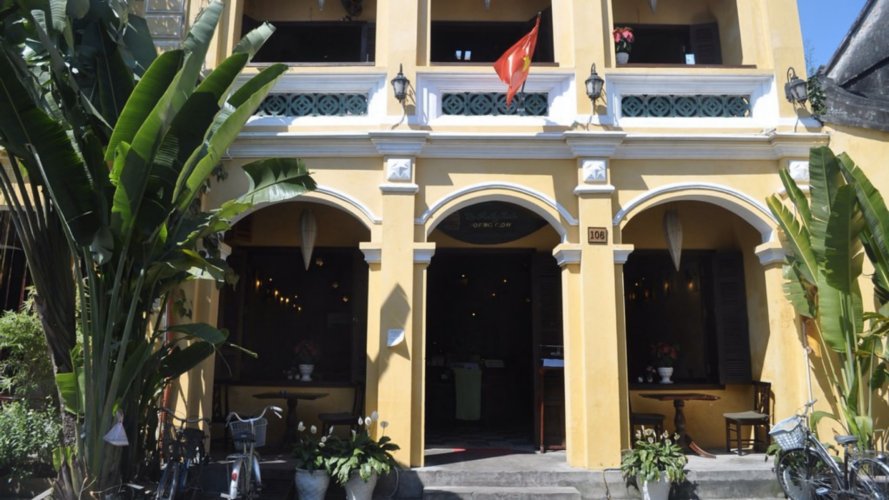
Hoi An boasts a vibrant culinary scene with a plethora of restaurants catering to various tastes and preferences. While it’s challenging to pinpoint the absolute best restaurants as personal preferences play a significant role, here are some highly regarded options in Hoi An based on their reputation up to my last knowledge update in September 2021:
1. Morning Glory:
Renowned for its extensive menu of Vietnamese dishes, this restaurant offers a wide range of local specialties in a cozy setting.
2. The Cargo Club:
This popular spot along the riverfront is known for its pastries, cocktails, and international cuisine. It’s an excellent choice for brunch or a relaxing evening.
3. Ancient Faifo:
Offering a blend of Vietnamese and European cuisine, this restaurant has a charming ambiance and an extensive wine list.
4. Red Bean Restaurant:
Located in the chic La Siesta Resort, it offers Vietnamese and international dishes with a modern twist, often praised for its presentation and flavor.
5. Mango Mango:
Known for its innovative fusion cuisine and picturesque riverside location, Mango Mango offers a diverse menu and beautiful sunset views.
6. Miss Ly Café:
A local favorite, this restaurant serves traditional Hoi An dishes in a simple but authentic setting.
7. Banh Mi Phuong:
Famed for its banh mi sandwiches, this small shop gained international recognition after being featured on a TV show.
8. Nu Eatery:
A hidden gem serving creative Vietnamese-inspired cuisine with a focus on fresh, locally sourced ingredients.
9. Reaching Out Tea House:
This unique, silent teahouse is staffed by hearing-impaired individuals and offers a serene setting to enjoy tea and snacks.
10. The Fisherman Vegan Restaurant:
Ideal for vegetarians and vegans, this restaurant offers a variety of plant-based dishes with a focus on fresh ingredients.
Remember that Hoi An’s culinary scene is ever-evolving, and new restaurants may have emerged since my last update. It’s also a good idea to check recent reviews and ask locals or fellow travelers for their recommendations when visiting Hoi An to discover the latest dining gems.
WHAT ARE THE BEST HOTELS TO STAY IN HOI AN?
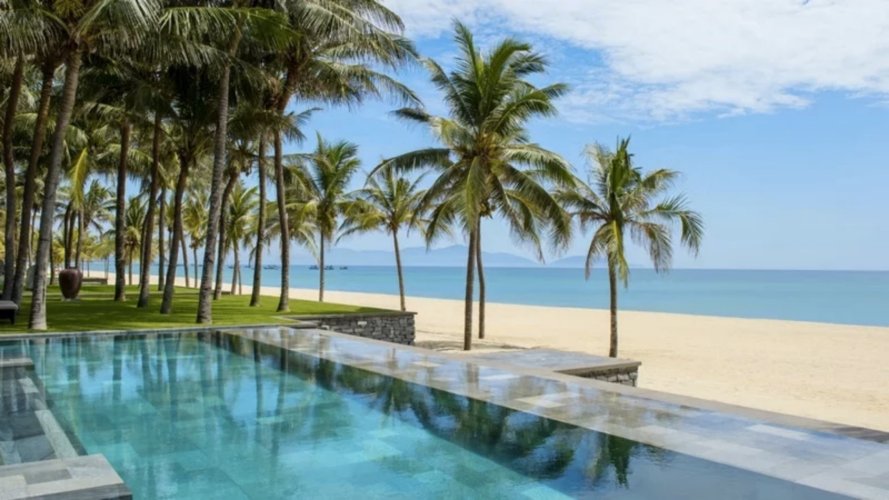
1. 5 – star hotels:
1. Four Seasons Resort The Nam Hai, Hoi An:
This beachfront resort offers luxurious villas, spa services, multiple swimming pools, and fine dining options.
2. Vinpearl Resort & Spa Hoi An:
Situated on a private island on the Thu Bon River, this resort offers modern rooms, extensive facilities, and beautiful river views.
3. Almanity Hoi An Wellness Resort:
This wellness-focused resort offers spa and holistic health services, along with elegant rooms and a tranquil atmosphere.
4. Palm Garden Resort:
Nestled on the shores of the South East Sea, this resort combines traditional Vietnamese architecture with modern luxury, offering a serene beachfront experience.
2. 4 – star hotels:

1. Hoi An Silk Marina Resort & Spa:
This riverside resort offers comfortable rooms, a spa, swimming pools, and easy access to Hoi An’s Old Town.
2. Hoi An Historic Hotel:
Located in the heart of the ancient town, this hotel offers a blend of traditional and modern comforts, with a charming ambiance.
3. Hoi An Central Boutique Hotel & Spa:
Situated near the historic district, this boutique hotel features cozy rooms, a spa, and a rooftop pool with views of the town.
4. La Siesta Hoi An Resort & Spa:
A riverside resort offering stylish rooms, spa services, and a peaceful atmosphere.
5. Hoi An Silkotel:
Set amidst lush gardens, this resort offers a serene environment, comfortable cottages, and a swimming pool. It is only 10 minutes to reach the old town of Hoi An.
6. Emm Hotel Hoi An:
This modern hotel is conveniently located near the Old Town and provides comfortable accommodations with a rooftop pool.
3. 3 – star hotels:
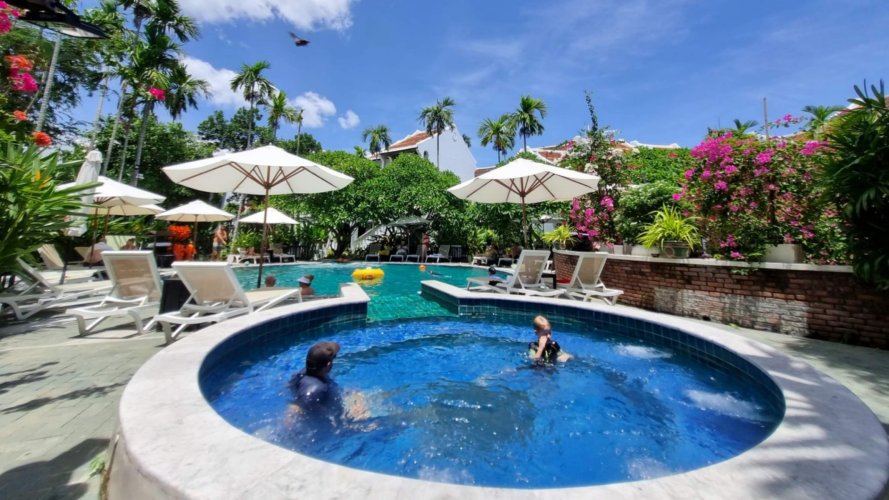
1. Pho Hoi Riverside Resort:
Located along the Thu Bon River, this peaceful resort offers comfortable rooms and scenic views.
2. Hoi An Lantern Hotel:
Situated in the heart of the Old Town, this hotel provides a convenient location for exploring Hoi An’s historic sites.
3. Hoi An Garden Palace & Spa:
With an outdoor pool and comfortable rooms, this hotel offers a pleasant stay just a short walk from the Old Town.
4. Kiman Hoi An Hotel & Spa:
A modern hotel with a rooftop pool, this property is within easy reach of the Old Town and nearby attractions.
5. Hoi An Ancient House Village Resort & Spa:
This charming resort features traditional Vietnamese architecture and modern amenities.
6. River Suites Hoi An Hotel:
Located near the riverside, this hotel provides spacious rooms and a peaceful environment.
7. Thanh Van 1 Hotel:
A budget-friendly option with clean and comfortable rooms, this hotel is a short distance from the Old Town.
WHAT ARE THE BEST HOME STAYS TO STAY IN HOI AN?
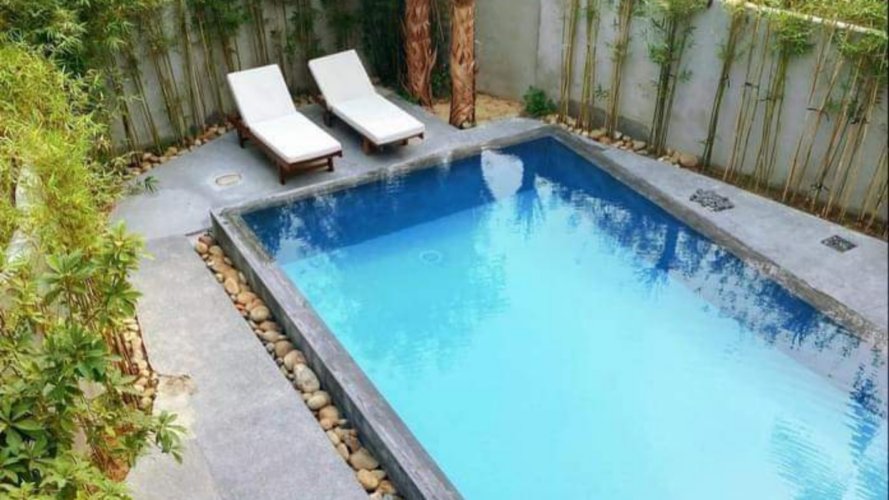
1. Green Valley Homestay:
Set amidst lush rice fields, this peaceful homestay offers a serene atmosphere and a glimpse into rural life.
2. Hoa Hoi Villa Hoi An:
A beautiful riverside homestay with comfortable rooms and a friendly host who can arrange activities and tours.
3. Daisy Homestay:
Located near the Old Town, this homestay offers clean and comfortable accommodations and a welcoming host.
4. An Bang Beach Dolphin Homestay:
Just a short walk from An Bang Beach, this homestay provides a laid-back coastal experience.
5. Villa Hoa Su Frangipani Riverside Resort:
Situated along the Thu Bon River, this homestay offers a peaceful garden setting and river views.
6. Tigon Homestay:
A charming homestay with cozy rooms, located within walking distance of the Old Town and nearby attractions.
7. Lemongrass Homestay:
This family-friendly homestay offers clean rooms and a lovely garden, creating a comfortable and welcoming environment.
8. River Palm Villas:
A riverside homestay with a relaxing ambiance and comfortable accommodations.
9. Bonsai Villa Hoi An:
This homestay features beautifully decorated rooms and a serene garden, providing a peaceful escape from the town’s bustle.
WHAT ARE BEST CAFES IN HOI AN?
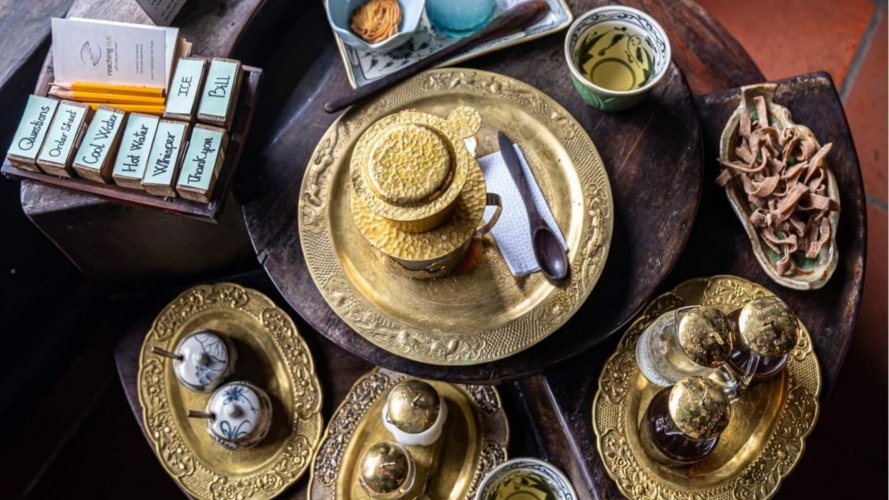
1. Reaching Out Tea House:
This unique tea house is staffed by hearing-impaired individuals and offers a serene environment to enjoy tea and snacks in silence.
2. Hoi An Roastery:
Known for its excellent coffee, this cafe offers a selection of freshly roasted beans and a cozy atmosphere.
3. The Espresso Station:
A favorite among coffee aficionados, this cafe serves a variety of high-quality coffee drinks and boasts a stylish interior.
4. Rosie’s Cafe:
A charming and cozy cafe with a garden setting, offering a range of coffee, tea, and delicious baked goods.
5. Mia Coffee:
Situated by the riverside, Mia Coffee offers picturesque views and a relaxed atmosphere to enjoy your coffee.
6. The Chef Espresso:
A small but welcoming cafe known for its artisanal coffee and delightful pastries.
7. Sound of Silence Coffee:
Located in a quiet alley, this cafe provides a tranquil escape from the busy streets and serves great coffee.
8. Faifo Coffee:
A chic cafe with a vintage feel, Faifo Coffee offers a variety of coffee and a welcoming ambiance.
9. Cocobox:
A health-conscious cafe serving organic coffee and a range of smoothies, juices, and light bites.
10. Hoa Coffee:
This traditional-style coffee shop offers a chance to experience authentic Vietnamese coffee culture.
WHAT ARE BEST TAILORS IN HOI AN?

1. Yaly
Yaly is a well-known tailor shop in Hoi An, Vietnam, that provides services for making apparel to order. Yaly Tailor is a well-liked option for individuals wishing to have customized suits, gowns, and other clothing created to their specifications while visiting Hoi An because of its reputation for excellent craftsmanship and its extensive selection of fabrics.
2. Bebe Tailor
In Hoi An, Vietnam, a renowned tailor shop called Bebe Tailor is well-known for its specialized tailoring solutions. They specialize in creating custom apparel, such as suits, gowns, and ao dai that are distinctively Vietnamese. Bebe Tailor is a well-liked option for custom-made clothing in Hoi An because to its talented tailors and large assortment of fabrics.
3. A Dong Silk
In Hoi An, Vietnam, a reputable tailor shop is called A Dong Silk. It provides custom tailoring services for suits, dresses, shirts, and more. It is renowned for its craftsmanship and attention to detail. A Dong Silk in Hoi An is a reputable source for custom apparel because to its extensive selection of textiles and talented craftspeople.
4. Thang Loi Silk
In Hoi An, Vietnam, there is a reputable tailor shop called Thang Loi Silk that specializes in making clothes to order. They make custom suits, gowns, and other clothing using skilled tailors and a range of fabrics. In Hoi An, Thang Loi Silk is a well-liked option for fitted apparel because of its reputation for fine craftsmanship and personal service.
5. Bill Ben Tailor
In Hoi An, Vietnam, Bill Ben Tailor is a reputable tailor shop that provides bespoke tailoring services. Custom suits, dresses, shirts, and other garments are created by Bill Ben Tailor, which is renowned for its attention to detail and wide selection of fabrics. It’s a well-liked option for fitted apparel in Hoi An because of the expert artisans.
WHICH ARE THE BEST PLACES FOR MONEY EXCHANGE IN HOI AN?
You can go to Kim Hong Phuc Gold Store near Hoi An central market to get a good exchange rate from your currencies into Vietnamese Dong. Or you can go to some local banks as follows to do the transaction but they usually require you to fill in the form and sometimes ask for passport.
– Agribank bank
– Vietcombank
– ACB bank
– Techcombank
– Sacombank
– VietinBank
– VietinBank
All have transaction offices in Hoi An.
WHAT ARE ESSENTIAL TIPS IN HOI AN FOR CONSIDERATION?
1. Check the weather forecast a weed ahead of your travel time
The weather is important in any travel. Therefore, make sure you check out the weather in Hoi An at least a week before your arrival time so you can positively reschedule your plan of travel.
2. Do not be confused with local currency
The local currency is call Vietnamese Dong but it has several bills that you need to take it into your consideration. And it causes common mistakes as the notes got many zeros on them and some notes have similar colors that you have to be careful.
3. Do not follow the middle man in town
When you are in town and suddenly there is someone who tries to be friendly coming close to you and ask some questions such as “Where are you from?”, “How long will you stay here?”, “Do you get clothes made in Hoi An?”. In fact, they are truly middle men who are waiting somewhere in the old quarter to make friends with you and take you to their shops or local shops in Hoi An market that gives you poor quality of clothes or sometimes overpriced that is unacceptable. My tip is to use the phone to find the best tailors in town or go to their official websites of well – known clothes shops in Hoi An. Since you find the addresses, you can go there on your own.
4. Be careful with vendors in town
As Hoi An is getting more popular with all tourists around the world, there are more and more local vendors coming to Hoi An to make a living. You can help them by buying something but you need to ask for permission to take picture of them or you have to deal the price first, otherwise it is overpriced than in the market.
WHAT IS THE BEST HOI AN TRAVEL AGENCY TO BOOK PRIVATE TOURS?
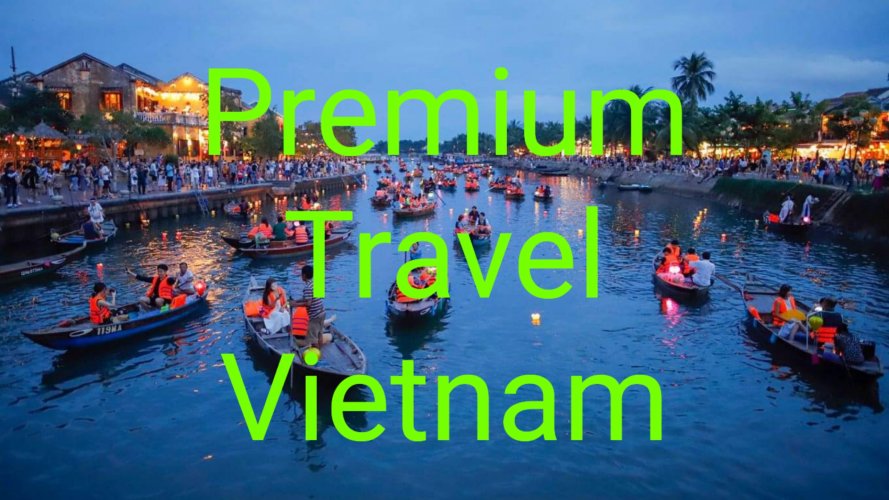
Finally, if you are traveling to Hoi An ancient town, Vietnam and would like to find the best Hoi An Travel Agency, please do not hesitate to contact us as follows:
Premium Travel Vietnam Co., Ltd
Tran Van Du street, Da Nang city, Vietnam
Email: premiumvietnamtravel@gmail.com
Whatsapp: +84 979613777
Websites: https://premiumtravel.info/
https://premiumtravelvietnam.vn/
